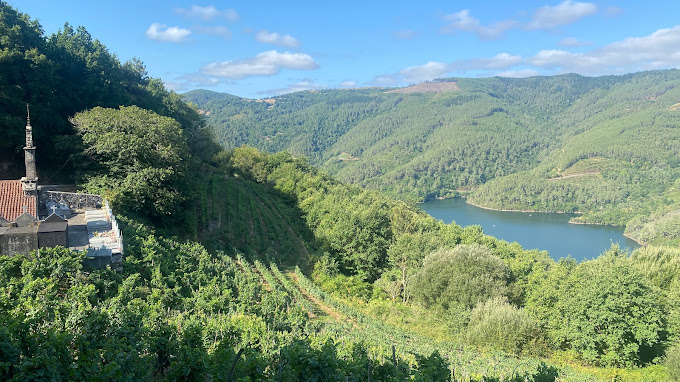Hola from Spain, where today was supposed to be a simple, relaxing excursion into the Ribeira Sacra. You know—wine, scenery, a little light philosophising about life. Instead, it turned into a bureaucratic standoff with a woman who held all the power and knew it.
It started like any other morning. Coffee, pastries, a quick round of Wordle. Patricia got it in three tries, which was just unnecessary, really. I overcomplicated mine, as usual, and ended up staring at the screen while Bertie sighed like he was personally disappointed in me. Connections was no better. I confidently grouped “Paella, Gazpacho, Rioja, and Chorizo” under Things You Eat in Spain, only for the game to tell me, very smugly, that they were actually just Things That Can Be Red.
Patricia, laughing far too much, asked me if I’d ever seen blue chorizo. No, Patricia. No, I have not.
By this point, I needed a win, and what better way to lift the spirits than by drinking actual spirits? Or, more accurately, wine. A drive through the Ribeira Sacra, a few vineyard visits, maybe a case to take home. That was the plan.
If you haven’t been, the Ribeira Sacra is ridiculous. It’s all steep, terraced vineyards that look like they shouldn’t even be possible, cascading down into the Sil River like a Roman amphitheatre. The Romans did, in fact, plant the first grapes here 2,000 years ago, and I like to think that if they came back today, they’d approve.
Patricia, obviously, was straight into her sketchbook before we’d even parked properly. “You don’t get views like this in Yorkshire,” she said, completely absorbed.
I was more interested in what our vineyard guide was saying. Something about heroic viticulture, a fancy way of saying that growing grapes on these sheer cliffs is an absolute nightmare. Half the harvest must be lost to gravity. But that struggle is what makes Ribeira Sacra wine taste the way it does—rich, earthy, a little wild.
And that’s when things started going downhill.
We’d just finished a lovely tasting, and obviously, we wanted to take some home. So we strolled over to the counter, feeling very pleased with ourselves.
The assistant smiled politely and said, “I’ll just need your NIE number.”
For the uninitiated, the NIE (Número de Identidad de Extranjero) is Spain’s way of keeping track of foreigners. You need it for everything—opening a bank account, buying a car, and, apparently, purchasing wine in irresponsible quantities.
Now, I was feeling very smug at this point, because we have NIE numbers. I patted my pocket, reached for my wallet, and—nothing.
No card.
Patricia checked her bag. Also nothing.
Now, at this point, you might be thinking, No problem, just tell them the number.
No. That would be far too easy.
“We can tell you the number!” I said, full of hope.
The assistant shook her head. “The system needs the card.”
Patricia, ever the diplomat, tried a different angle. “Couldn’t you just look us up? We’re in the system.”
A slow, sympathetic shrug. “No card, no wine.”
We pleaded. We reasoned. We tried, with all the charm we had.
Nada.
So, we did what any reasonable people would do in this situation—we bought as much wine as possible without an NIE card.
The assistant rang up our half-case while we stood there, plotting our inevitable return with proper documentation.
Meanwhile, Bertie had spent the entire ordeal trying (and failing) to make friends with the vineyard’s cat, who was having absolutely none of it.
As we loaded our not-quite-full-enough box into the car, Patricia turned to me, grinning. “Well, at least we’ve got an excuse to come back.”
She’s not wrong. Next time, though, we’re buying double.
